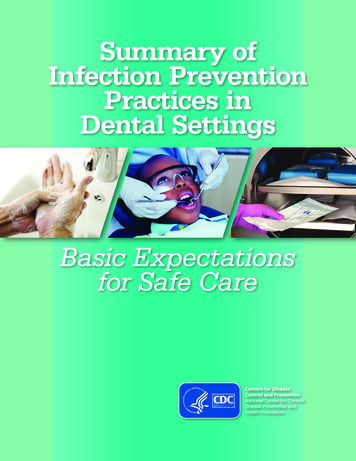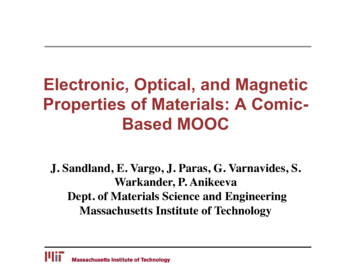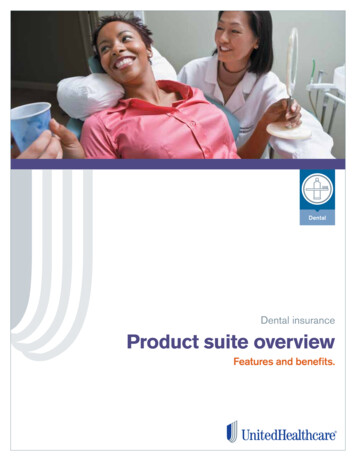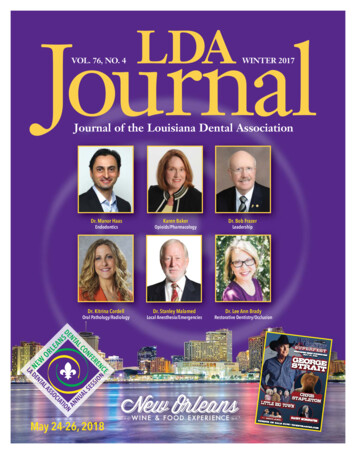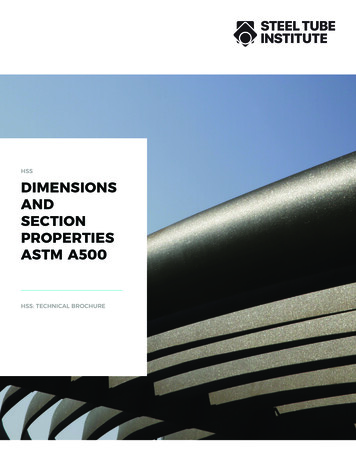
Transcription
Dental Materials مثنى شعبان رجب . م . أ جامعة تكريت – كلية Properties of Dental Materials طب االسنان Importance of Studying Properties of Materials Materials used to replace teeth or parts of teeth must withstand oralenvironment and forces of mastication Materials must be cleaned and polished by a variety of materials Clinical experience and research relate clinical success to certainproperties of materials Critical physical properties are established which protects thepublicPROPERTIES OF DENTAL MATERIALSI. Physical PropertiesII. Thermal PropertiesIII. Electrical PropertiesIV. Optical PropertiesV. Mechanical PropertiesI. Physical Properties1. Density The amount of mass of a material in a given volume. Density units are g/cm2. Metallic maxillary prosthesis should be as thin as possible2. Viscosity The ability of a material to flow. Thick liquids flow poorly, thin liquids flow easily. Viscosity is measured in grams/meter.second or pois(p)3. Hardness The resistance of a material to indentation. It is measured by scientific instruments that press acharacteristically shaped tips made of steel or diamond. Hardness is calculated based on the size of the indentation, the loadon the tip, and the shape of the tip. Brinell, Rockwell, Vickers, and Knoop tests.1
Dental Materials مثنى شعبان رجب . م . أ جامعة تكريت – كلية طب االسنان 4. Abrasion Resistance Harder materials more abrasion resistance. Restorations must be hard enough to resist abrasion, but not sohard to wear away the opposing teeth.5. Solubility and Sorption Solubility– Susceptible to being dissolved Sorption– Adsorption plus absorption Adsorption– Natural process where molecules of a gas or liquid adhere tothe surface of a solid Absorption– Passage of a substance into the interior of another bysolution or penetration6. Adhesion The force of attraction between the molecules/atoms of twodifferent surfaces as they are brought into contact. Ex: .Plaque or calculus attaching to tooth structure. Salivaattaching to denture surface and to tissue. Cohesion: Force of attraction between molecules/atoms within onematerial. (Not on the surface).2
Dental Materials مثنى شعبان رجب . م . أ 7. Wettability جامعة تكريت – كلية Measure of the affinity of a liquid for a solid as indicated by طب االسنان spreading of a drop Observed by shape of the drop of liquid on the solid surface– Flatter shape indicates more wettingII. Thermal Properties1. Coefficient of Thermal Expansion Linear coefficient of thermal expansion: a measure of how much itexpands per unit length if heated one degree higher. LCTE Fractional change in length/Change in temperature. LCTE (L2-L1/L1)/T2-T1Thermal Dimensional Change The expansion or contraction of a material due to temperaturechanges. A restoration may expand or contract more than natural teeth withchanges in temperature. This leads to leakage at the margins calledpercolation.2. Thermal Conductivity The rate of heat flow through a material. The units of thermal conductivity are calories/second.meter.degree. Materials have different rates of conducting heat Metals have higher value than plastics or ceramicsTherefore, metals would cause patient to feel moresensitivity Enamel and dentin are poor thermal conductors In deep restorations, a cement base will be used as an insulator Gold causes the most sensitivity3. Boiling & Melting Points Any material has its certain and specific boiling and melting points. Mixtures have a boiling and melting range rather than a specificboiling and melting points. Some materials do not boil or melt, but decompose if heatedsufficiently, like wood.3
Dental Materials مثنى شعبان رجب . م . أ جامعة تكريت – كلية 4. Vapor Pressure A measure of liquid's tendency to evaporate. Materials with high vapor pressure at room temperature are االسنان useful طب as a solvent.III. Electrical Properties1. Galvanism Galvanism– Generation ofelectrical currents inmouth– Results frompresence ofdissimilar metals inmouth– Causes pain andtastes metallic Corrosion– Dissolution ofmaterials in mouth– Results frompresence of dissimilar metals– Roughness and pitting Tarnish– Surface reaction of metals to components in saliva or foods2. Electrical Conductivity The ability of a material to conduct the electrical current. It is important to consider during electrosurgery or electrical pulptesting.IV. Optical Properties1. Color and Esthetics Light source strikes an object. Reflected light comes off the object and is sensed by receptors inthe retina of the eye. If person not color blind, info from the retina sorted out by brainand colors are “seen”.Munsell Color System System to measure colors.4
Dental Materials مثنى شعبان رجب . م . أ Based on three indices:Hue What color is it?Value Lightness of the colorChroma Saturation of color. Value increases from bottom to top. Chroma increases from center outwards جامعة تكريت – كلية طب االسنان 2. Metamerism Objects appear to be different colors in different lights. Source of great difficulty in shade matching for restorations.3. Fluorescence Material becomes source of light. Emits lights when a beam oflight is shined on it. Natural teeth display fluorescence. Some porcelains do not. Appearto be missing in black light (UV).4. Opacity, Translucency, Transparency Transparent Clear, like glass. No light is absorbed. Translucent Part of light transmitted through, part absorbed, partreflected. Opaque All light absorbed.V. Mechanical Properties Physical science and laws of mechanics act on all materials. Useful to examine how a material reacts under certain conditions. Helps to predict material’s usefulness as a restorative.Three Basic Forces A. Tensile Force that pulls an object apart. Object pulled by thisforce is under tension. B. Compression Force that squeezes an object together. Such anobject is under compression. C. Shear Force that slides the top of the object over the bottom.Like a deck of cards stacked on table. You put force on the topcards and slide them over the rest of the deck.Intraoral Biting Forces Greatest in the molar area –580Newtons. (132lbs.)Premolars – 310Newtons (70.5 lbs.)Cuspids – 220Newtons (41lbs.)Partial and complete dentures –111Newtons ( 25 lbs.)5
Dental Materials مثنى شعبان رجب . م . أ جامعة تكريت – كلية Stress طب االسنان Stress– Force per unit area– For a given force, the smaller the area applied to, the largerthe value of the stress– Increased force on a smaller area will cause increased stressand vice versa– Stress common in mouth because biting surfaces are smallTensile, Compressive and Shear Stress Tensile– Material is pulled apart Compressive– Material is squeezed together Shear– One portion of the material is forced to slide by anotherportionStrain The deformation or change in dimension an object under stressexperiences. Strain (L1-L0)/L0 Stress-strain curves– Apply forces to a material to see what happens6
Dental Materials مثنى شعبان رجب . م . أ جامعة تكريت – كلية Elastic vs. Plastic Strain Elastic strain: Completelyreversible. Disappears when forceis removed. Plastic strain: Permanentdeformation of the material thatnever recovers after force isremoved. طب االسنان Stress-Strain Curves Straight line portion of thecurve –Elastic behavior. Slope of the line Stiffnessof the material Stiffness orresistance to deformationunder stress ElasticModulus or Young’sModulus Proportional Limit ElasticLimit Stress above whichthe material no longerbehaves totally elastically.Maximum stress at which material recovers completely. Yield Strength Stress at some value of permanent deformation(usually .001). Always slightly higher than Proportional or ElasticLimit. Ultimate Strength The stress at which fracture occurs.Elongation and Compression Percent of elongation– Amount of deformation that material can withstand beforerupture when material is under tensile stress Percent of compression– Amount of deformation before rupture when material isunder compressive stress Both are measures of ductility and malleability Ductile materials 5%elongation at rupture. Opposite of ductile material is Brittle material. Brittle materialshave less than 5% elongation at rupture.7
Dental Materials مثنى شعبان رجب . م . أ جامعة تكريت – كلية Resilience, Toughness Resilience– Energy required to deform amaterial permanently is a criterionof its resilience Toughness– Energy necessary to fracture amaterial is measure of toughness طب االسنان Stress-Strain CurvesStrain-time Curves Used for materials in which the strain is dependent on the time theload is maintained It can be time dependent and recoverable or time dependent andnot recoverable If a load is applied for a longer time or the magnitude of the load isgreat then the amount of permanent strain will be more Also dependent on rate of application of the load8
Dental Materials مثنى شعبان رجب . م . أ جامعة تكريت – كلية Dynamic Properties Previous properties are classified as static loads due to slow طب االسنان application of load Dynamic properties are those that occur at high rates of loading,such as from an impact Important in mouth protectors due to stiffness of material & abilityto absorb energy9
properties of materials Critical physical properties are established which protects the public PROPERTIES OF DENTAL MATERIALS I. Physical Properties II. Thermal Properties III. Electrical Properties IV. Optical Properties V. Mechanical Properties I. Physical Properties 1. Density

